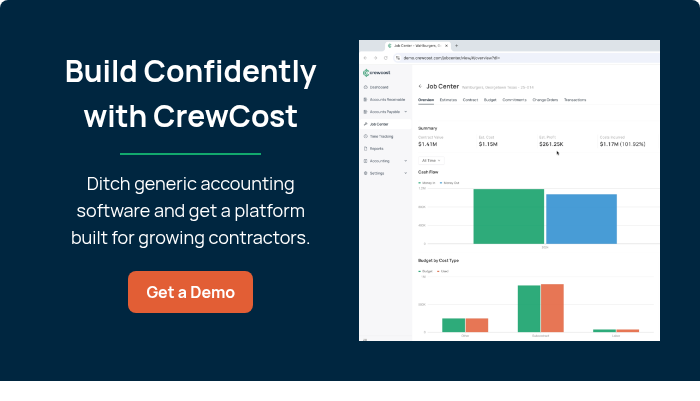Running a construction business is expensive. From ordering materials to hiring subcontractors, there are a ton of expenses to keep track of, and if they’re not accounted for, they can quickly eat away at your profit. One particular expense that can easily be missed in bids is overhead costs. Unlike expenses that are directly tied to completing a job, think of overhead as any indirect costs that fall under the umbrella of operating your company.
Since they’re not tied to a specific job, it’s easy to underestimate overhead costs – or forget to factor them in entirely. In this overview, we’ll look at how to identify and manage overhead so you can keep your profit goals on track.
Key Takeaways
- In construction, overhead costs are the costs you incur while running your company, whether you have any jobs or not.
- There are three types of overhead costs: fixed, variable, and semi-variable.
- Proper tracking of overhead is key to ensuring your job estimates and bids are accurate.
What are Overhead Costs?
Your overhead costs represent all of the indirect expenses associated with running your construction company. Some common examples include things like:
- Office Rent
- Insurance
- Utilities
- Legal Fees
- Office Supplies
- Office Payroll
- Advertising
- Accounting Fees
- Travel
All of these are ongoing costs that aren’t associated with a particular job, but rather with running your business. No matter how busy your company is, or how a job goes, you’ll still be paying them. Because they’re not necessarily tied to income production, accounting for these costs can be challenging. To help untangle things, let’s look at the three different types of overhead costs you’ll run into.
The Three Types of Overhead Costs
All overhead costs are fixed over the short-term, but can become variable or semi-variable over the long-term. That’s why we recommend evaluating them at least on a yearly basis. Here’s a quick breakdown of fixed, variable, and semi-variable costs.
Fixed – Fixed overhead describes any costs that stay the same over time, no matter your company’s income. A common example here is the rent you pay for your office space each month. Sometimes you’ll hear these described as “dead costs”, because they have to be paid even if there’s no revenue coming in.
Variable – On the flip side, variable overhead costs change often, and typically fluctuate with how busy your business is. Sales and marketing costs, legal expenses, and equipment maintenance are all examples of variable costs you might incur.
Semi-variable – As the name suggests, semi-variable costs are a combination of the two. It includes spending that, though partially independent of your revenue, may have cost elements that rise or fall with your business volume. For example, say you picked up a large job and need more warehouse space – you’re incurring a larger cost due to increased business volume. When allocating semi-variable costs, we recommend separating the fixed cost elements from the variable portion.
Ultimately, while categorizing, tracking, and allocating these expenses can be tricky, mastering this process is a crucial part of keeping your company in good financial health. Luckily, the process is easier than ever with the help of specialized construction accounting software.
👉🏼 Check out our full guide to construction accounting.
The Importance of Accurate Overhead Tracking
In a typical project, you’ll use job costing to keep track of labor, materials, and other project-specific spending. The challenge is that overhead costs don’t neatly fit into this process – and because of this, it’s not uncommon for overhead to be underestimated or neglected completely. This isn’t an oversight you want to deal with, because it can tank your chances of meeting your goals for profit margins.
By consistently applying a predetermined overhead percentage to every job estimate, bid, and budget, you can make sure overhead is always accounted for. We’ll get into the specifics of how to do this in the next part of this series, but for now, here’s a quick overview of the two methods you can use to capture and allocate overhead costs.
Project-based allocation is the most commonly used method. Put simply, this involves dividing your total annual overhead costs by your total direct job expenses to get a percentage.
Labor-based allocation divides your total annual overhead by your company’s yearly fully-burdened labor spending. This will give you a dollar amount you can add to job labor estimates.
When implemented properly, either of these methods will help you cover your overhead costs and keep your business profitable. Check out part two of our overhead series for a more in-depth look at overhead allocation.
Overhead Cost Management Made Simple
While overhead costs can make up a large part of business expenses, managing them doesn’t have to be complicated. With CrewCost’s construction accounting software in your toolbox, you can take the guesswork out of overhead cost allocation – and streamline your entire accounting process while you’re at it.
Made by contractors for contractors, CrewCost goes beyond generic accounting software to give you the tools you actually need to succeed in an ever-changing construction industry.
💥 Schedule a demo and see it in action.

